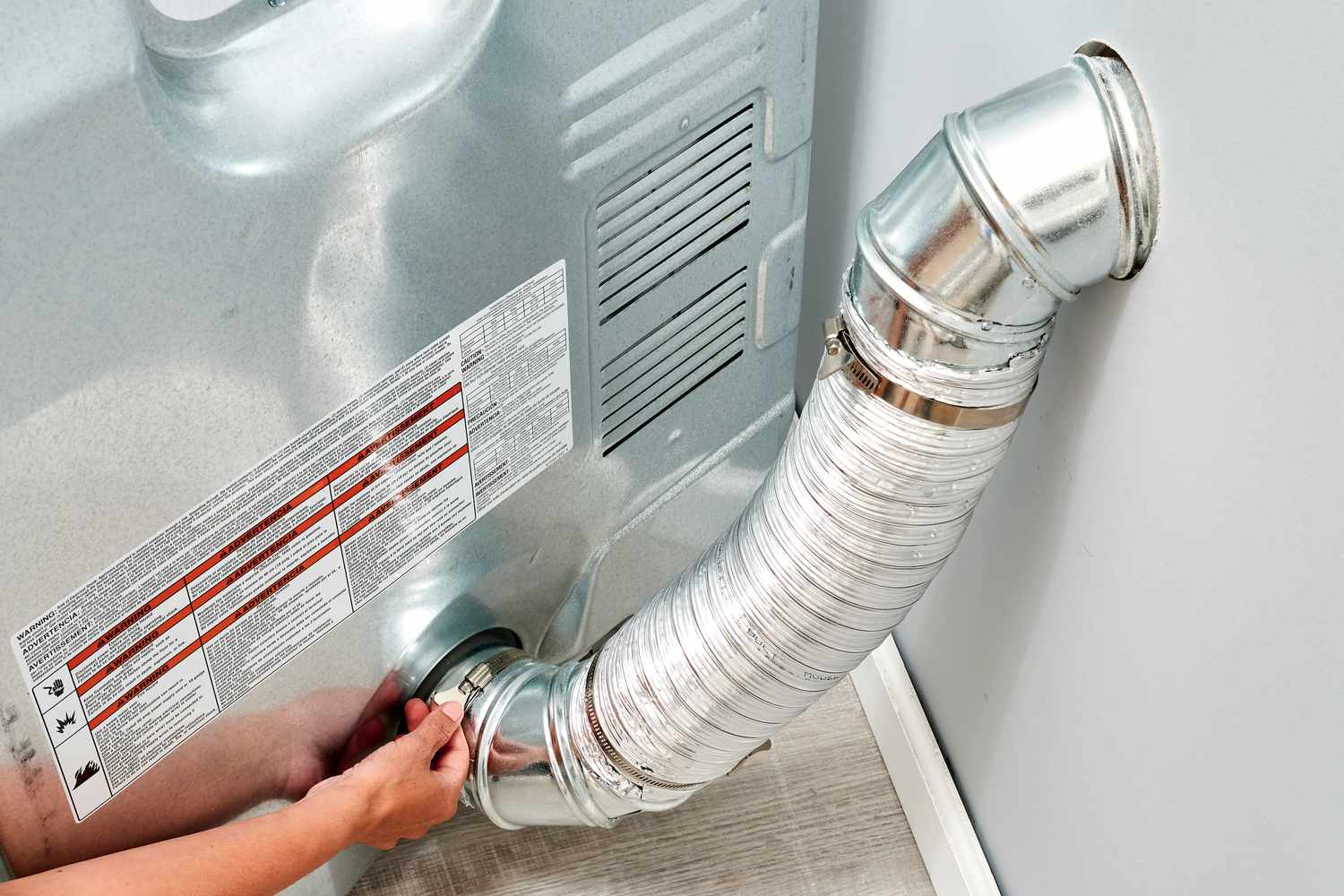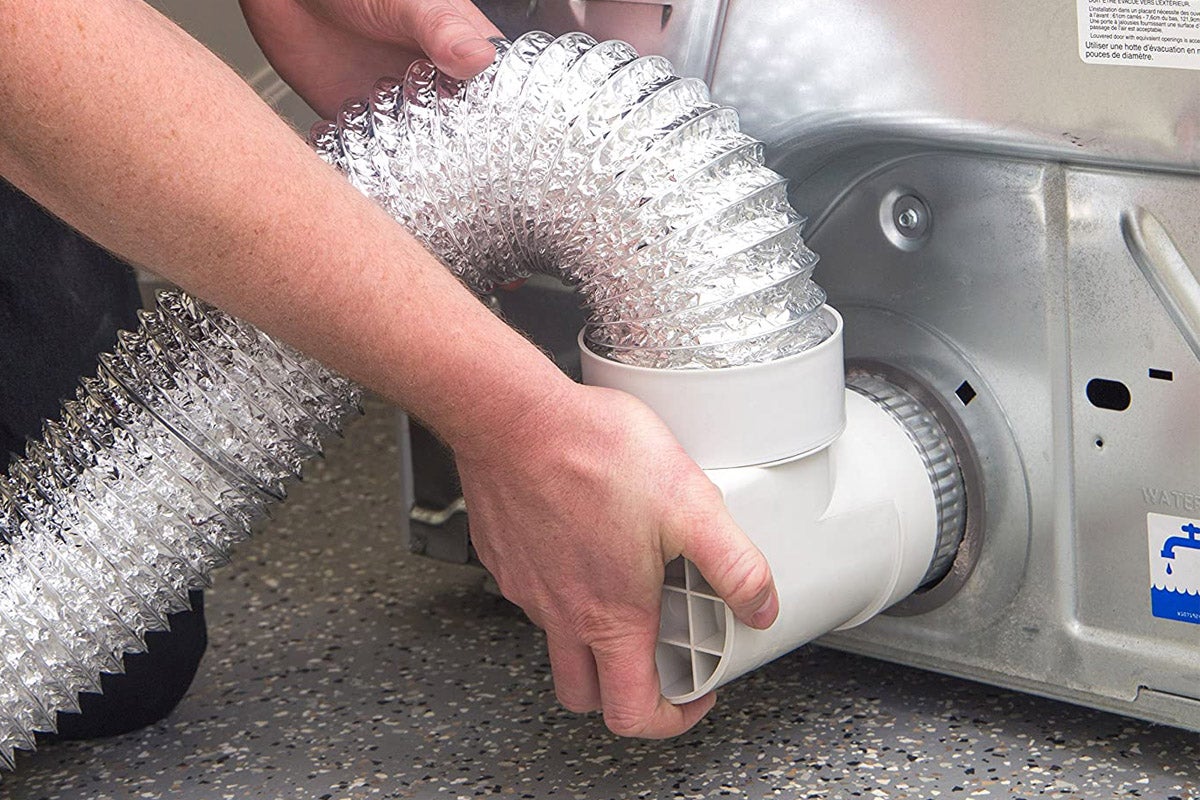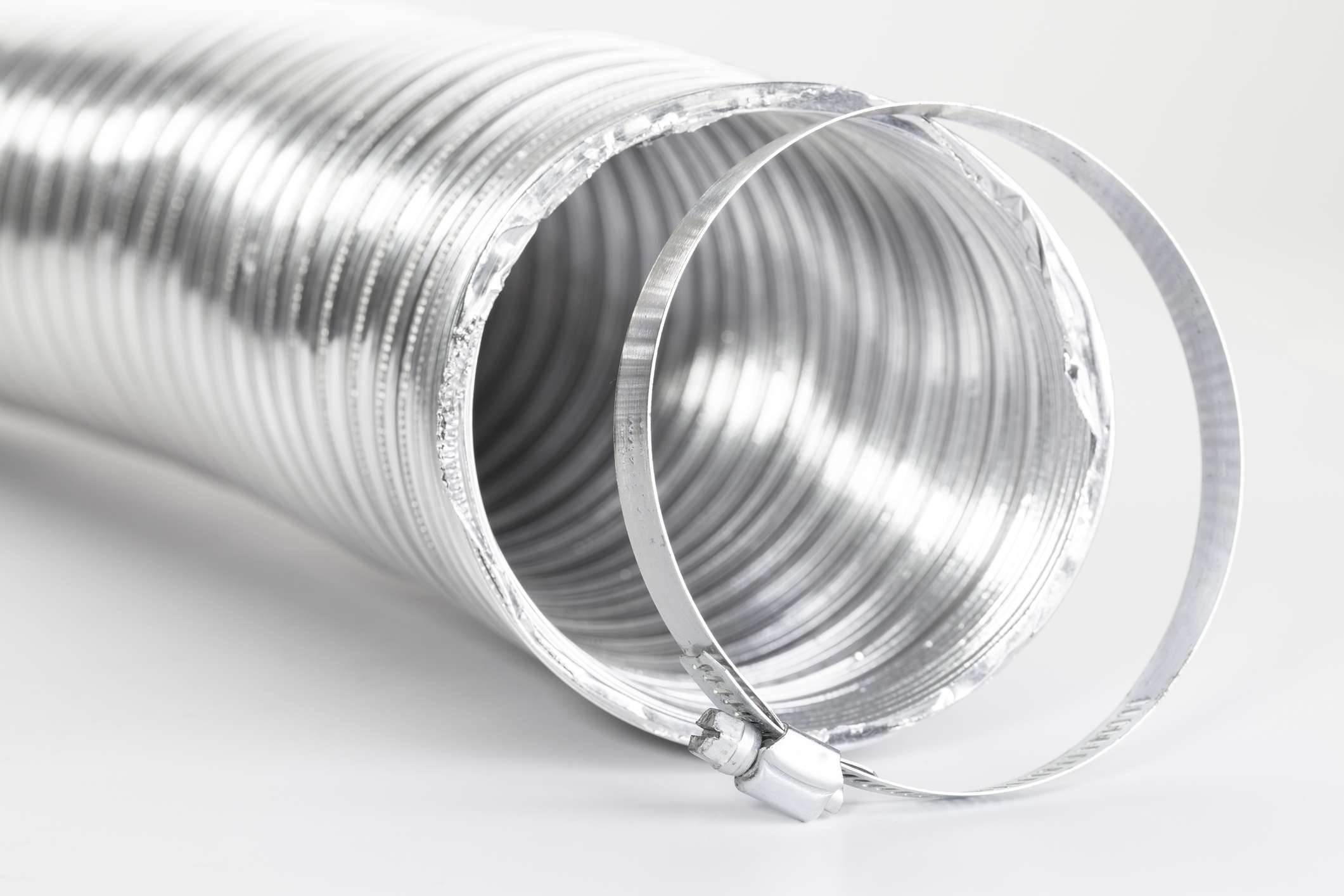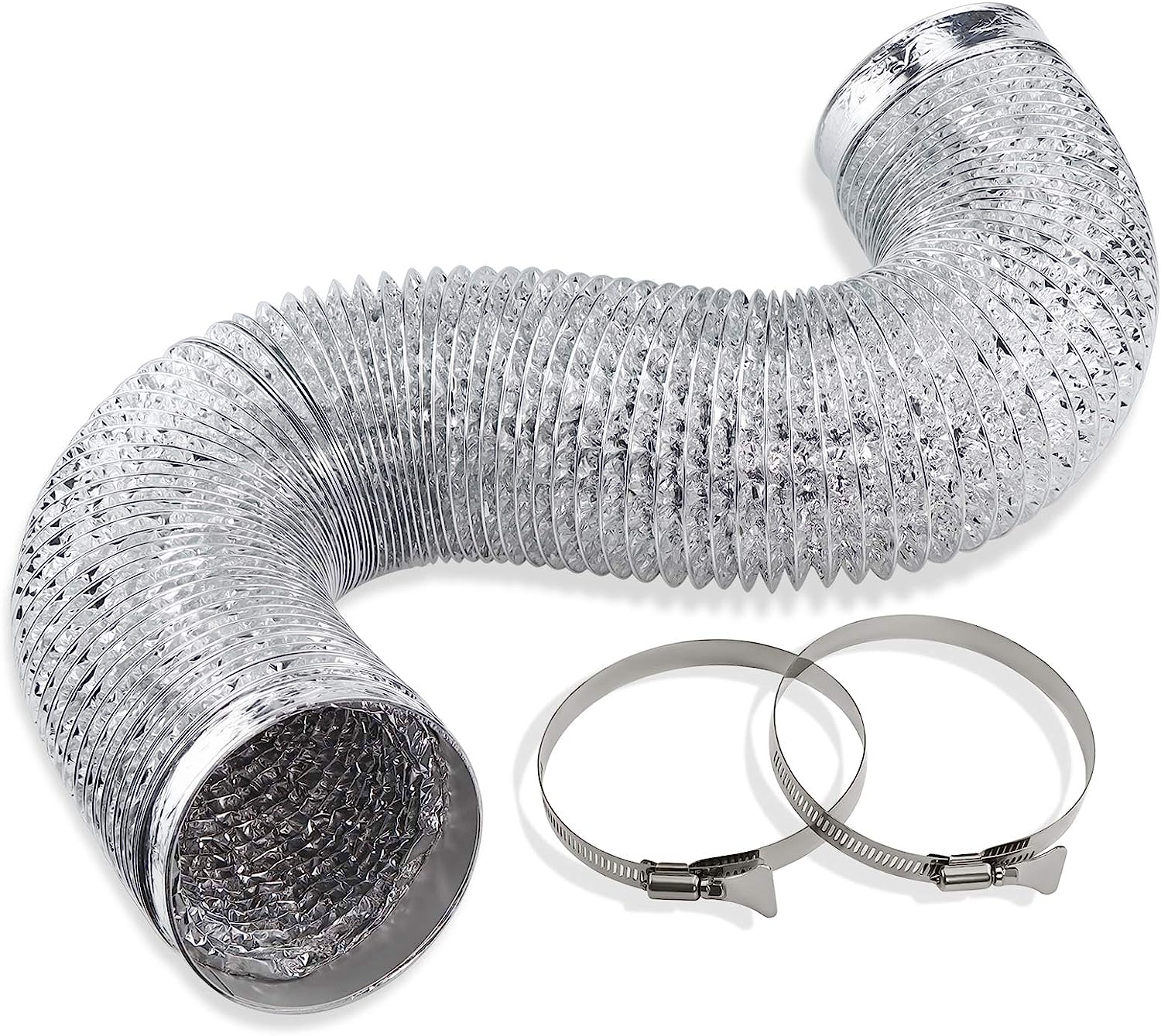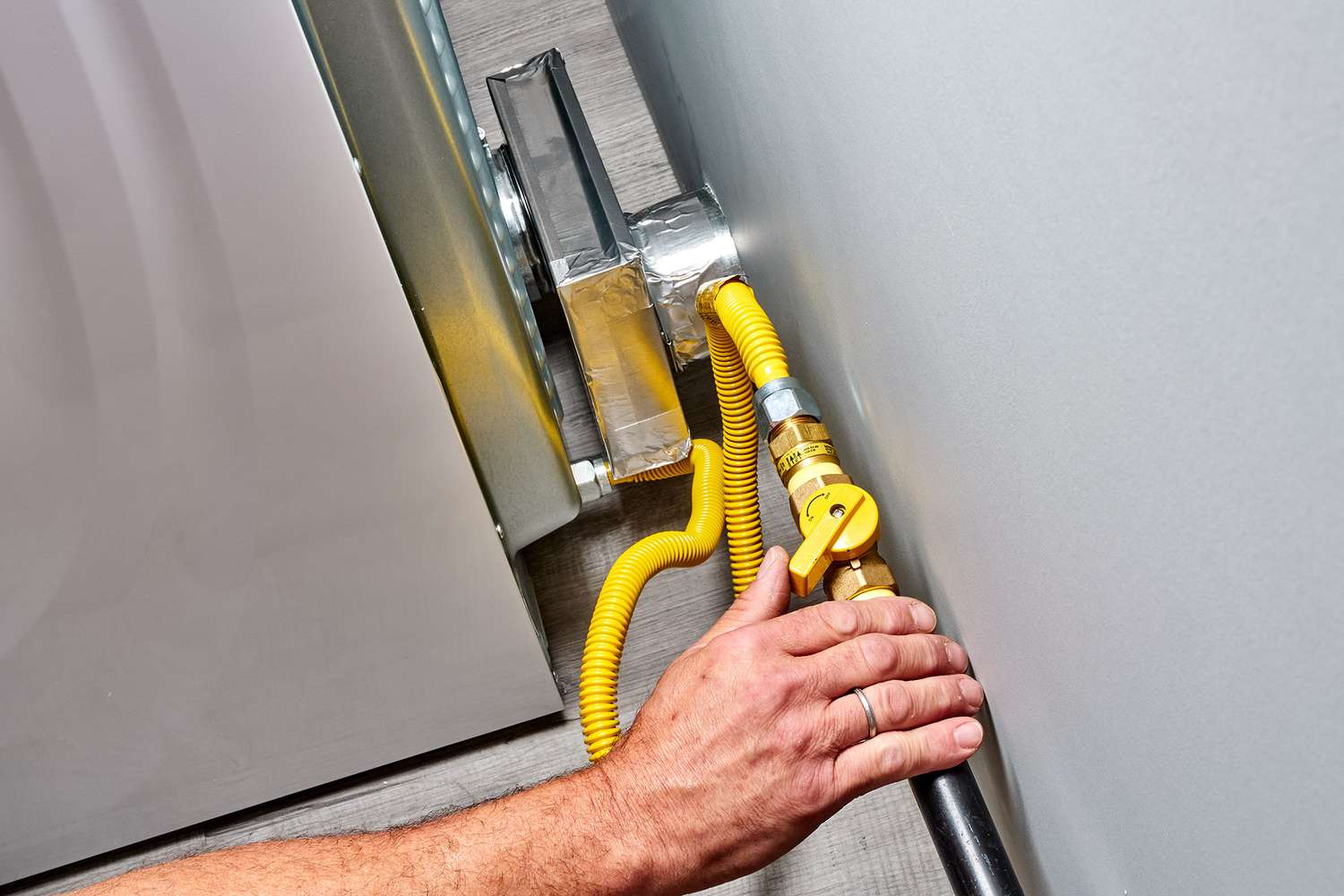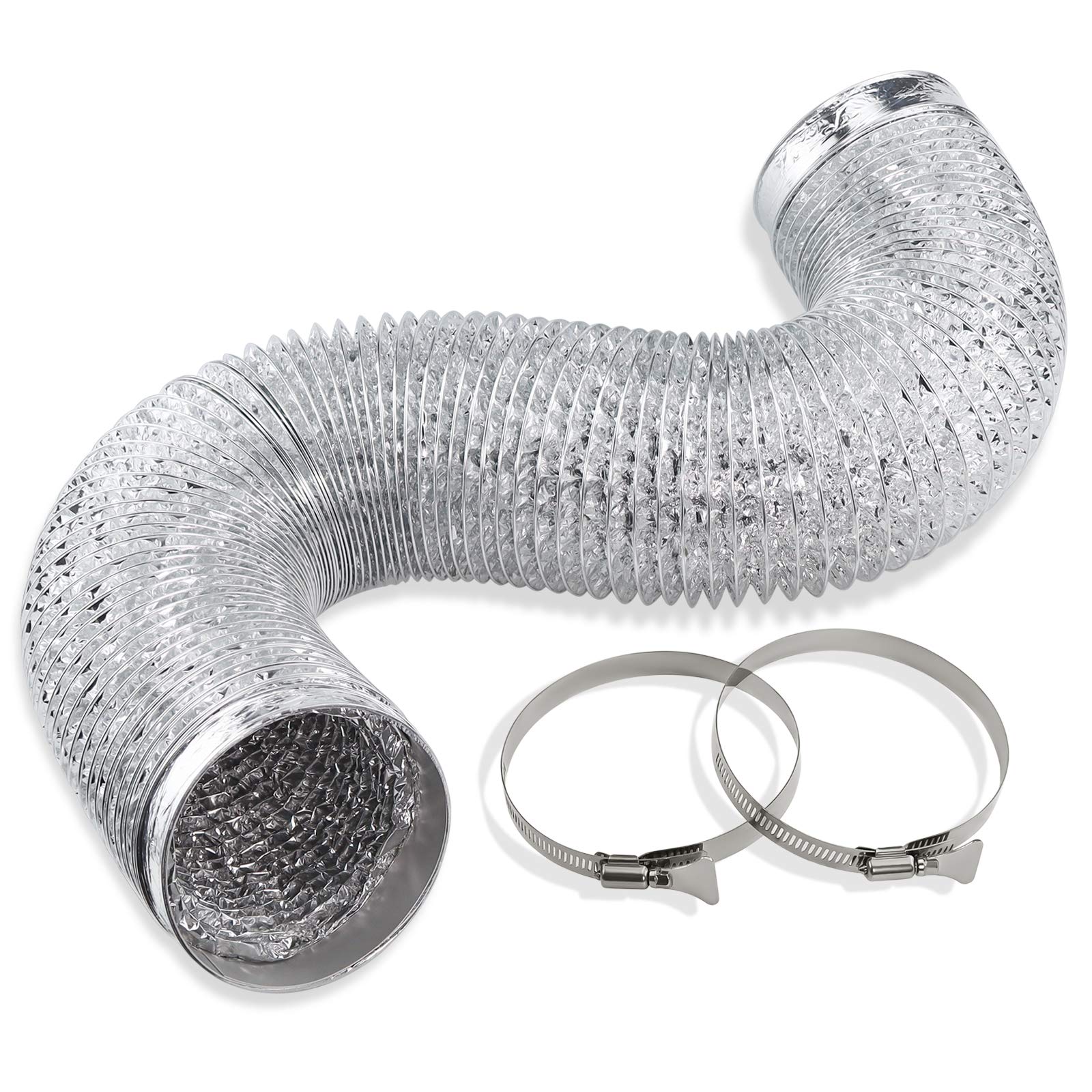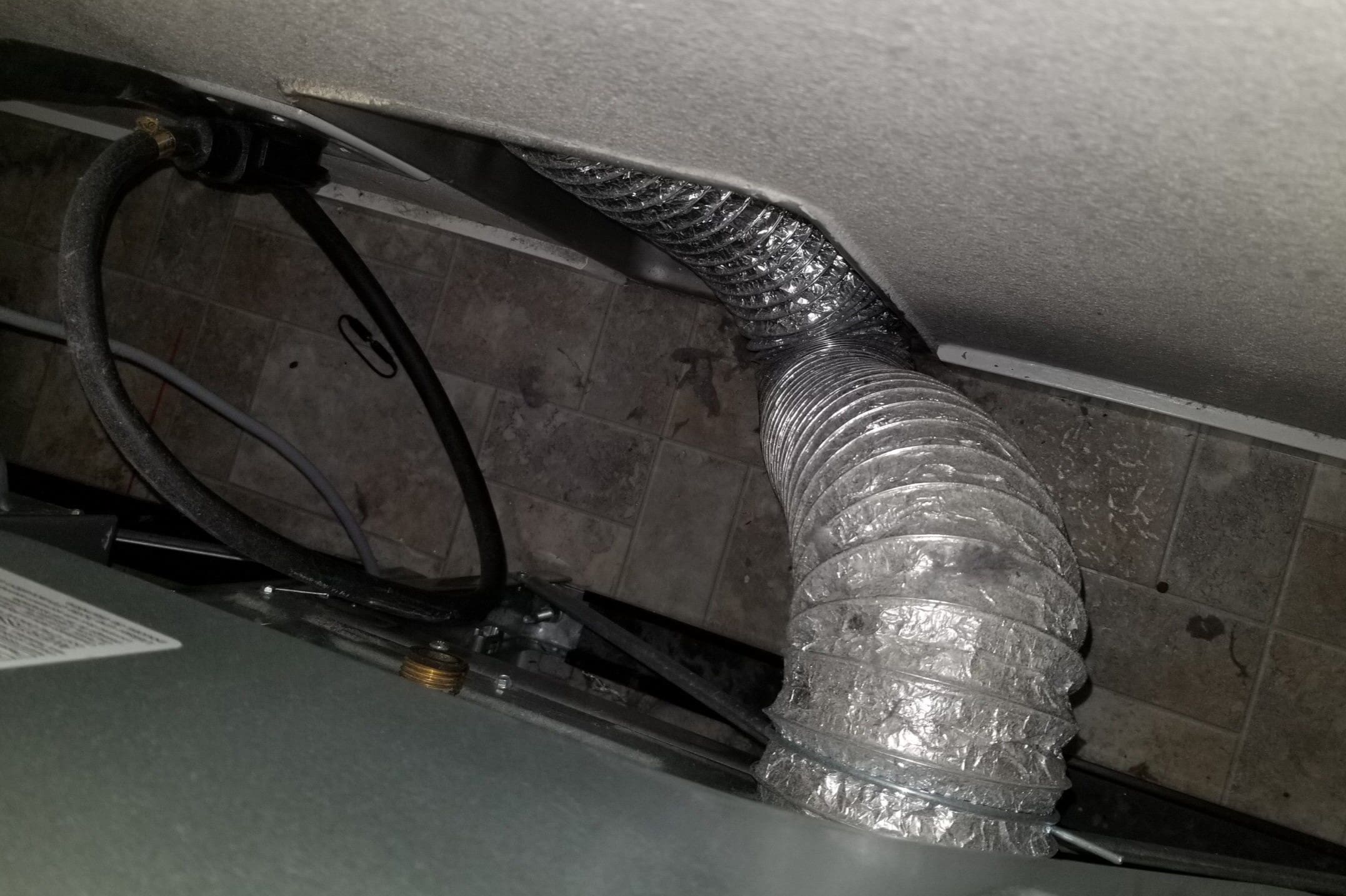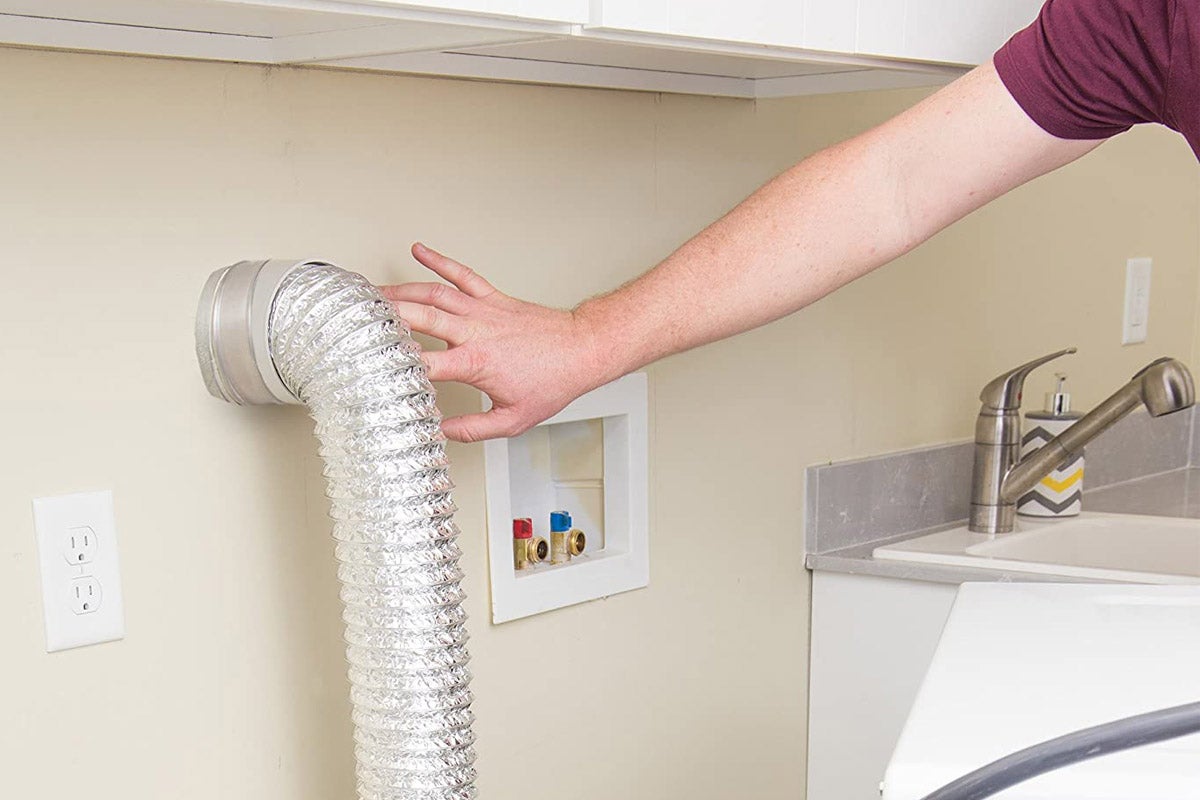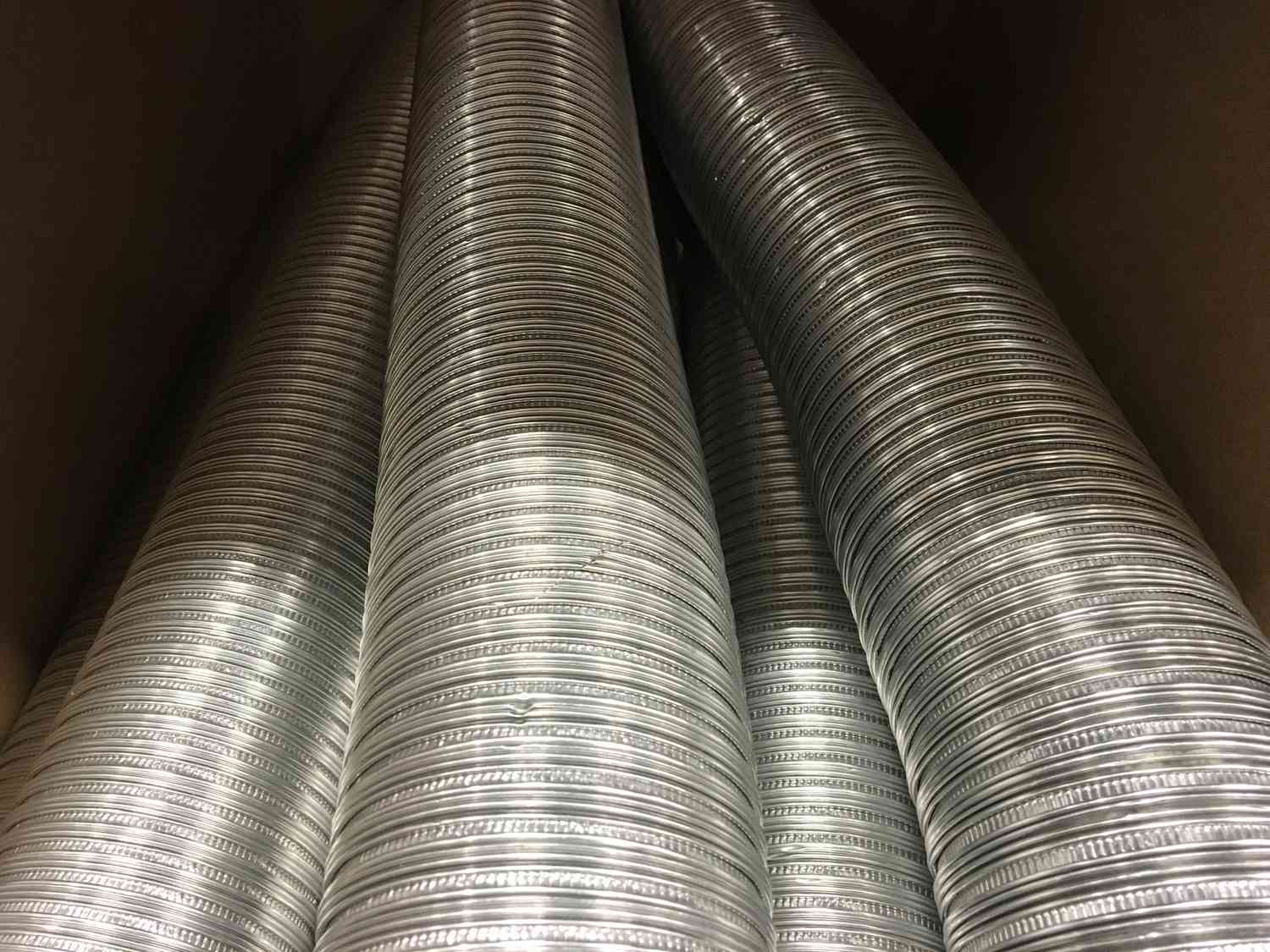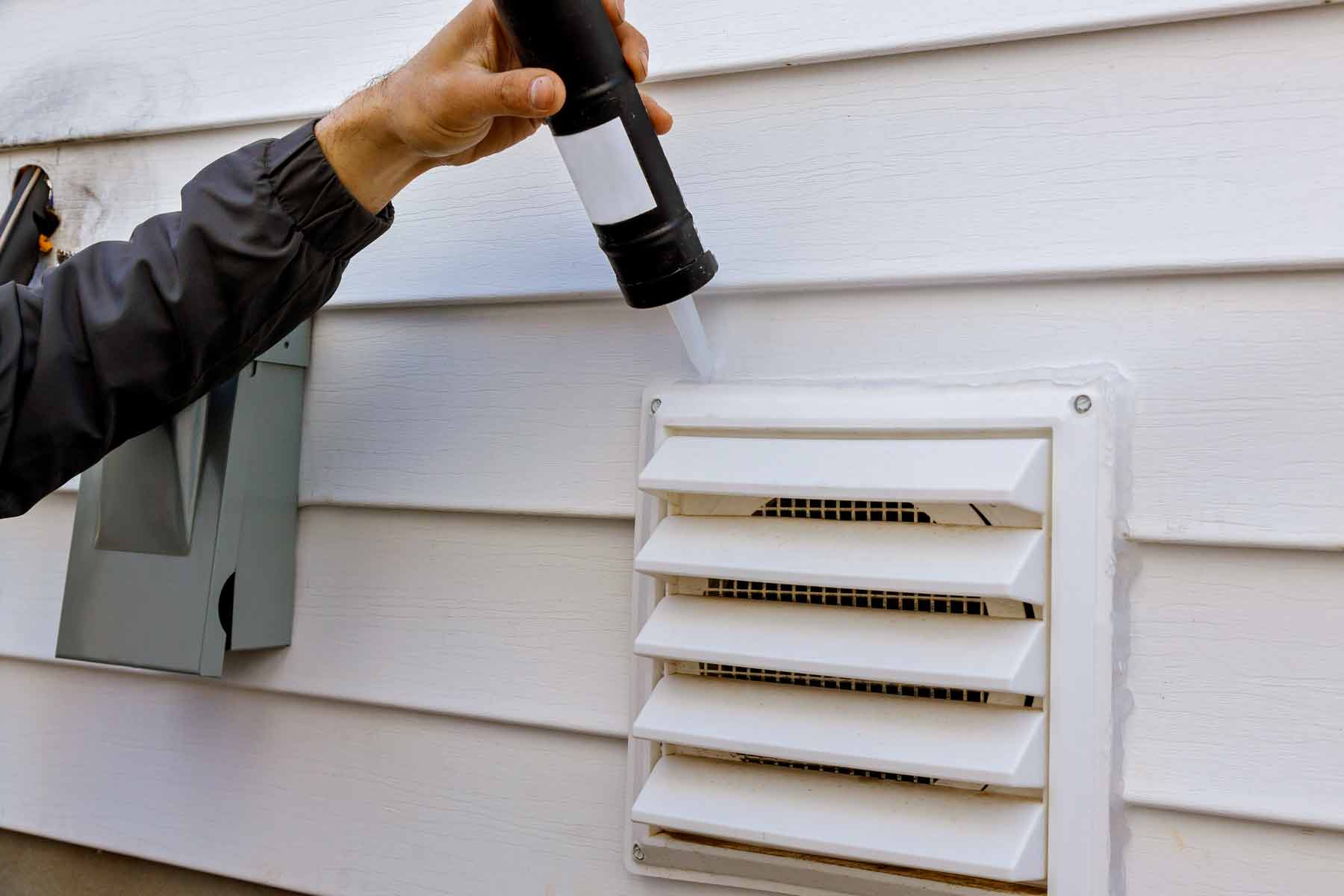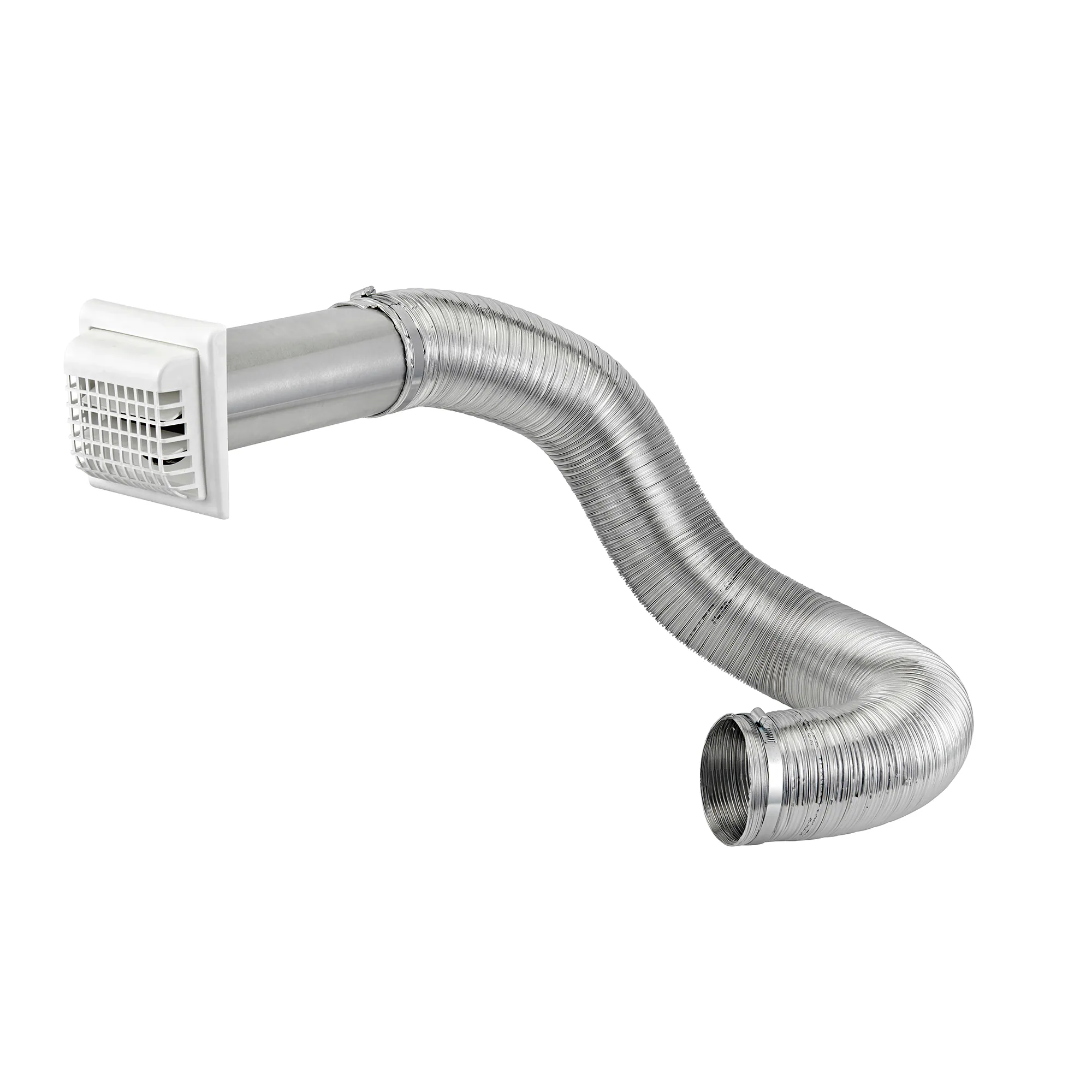Home>Home Maintenance>Which Dryer Vent Hose Is Best
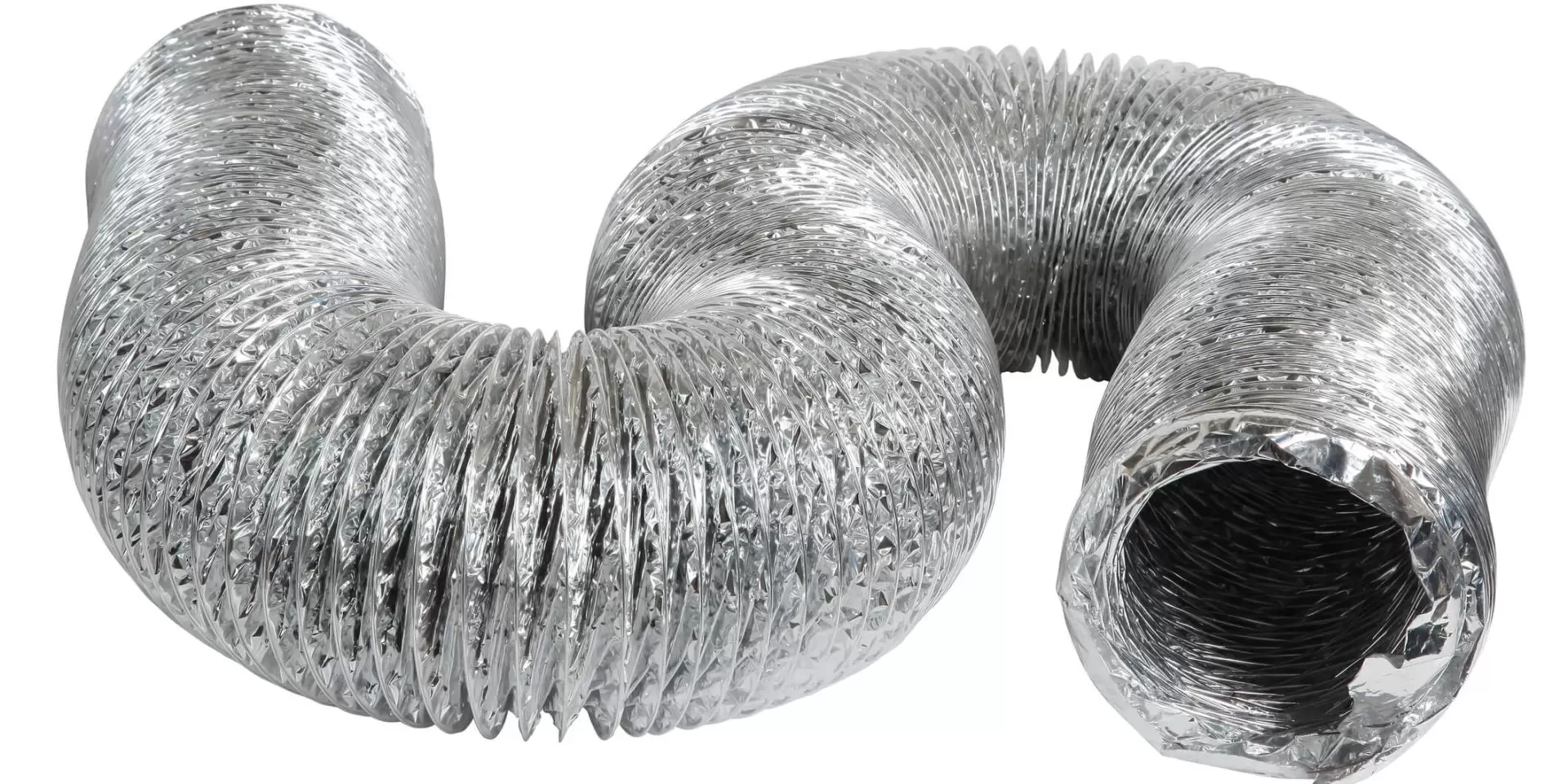

Home Maintenance
Which Dryer Vent Hose Is Best
Modified: March 6, 2024
Discover the best dryer vent hose for your home maintenance needs. Find out which one is durable, efficient, and ensures proper air flow.
(Many of the links in this article redirect to a specific reviewed product. Your purchase of these products through affiliate links helps to generate commission for Storables.com, at no extra cost. Learn more)
Introduction
Welcome to the world of home maintenance, where even the smallest details can make a big difference. In this era of modern convenience, one household appliance that has become an indispensable part of our lives is the dryer. Whether it’s drying a load of laundry or rejuvenating your favorite blanket, a high-quality dryer can make all the difference.
While most of us focus on the features and performance of the dryer itself, we often overlook a critical component that plays a crucial role in its efficiency and safety – the dryer vent hose. A dryer vent hose is the conduit that connects the dryer to the outside, allowing hot air and moisture to be properly vented out of your home. It’s essential to choose a reliable and efficient dryer vent hose to ensure the optimal performance and safety of your dryer.
In this article, we will delve into the importance of a good quality dryer vent hose and explore the various types available in the market. We will also discuss the key factors to consider when choosing the best dryer vent hose for your specific needs. So, let’s dive in and discover which dryer vent hose is best for you!
Key Takeaways:
- Choose an insulated flexible vent hose for optimal energy efficiency and reduced condensation, especially in colder climates or for those seeking energy savings.
- Prioritize durability with semi-rigid aluminum or flexible aluminum vent hoses, offering enhanced resistance to tearing and leaking for a longer lifespan.
Read more: How To Connect A Dryer Vent Hose
Importance of a good quality dryer vent hose
When it comes to the operation of your dryer, the vent hose may seem like a small and insignificant component. However, it plays a critical role in ensuring the efficiency, safety, and longevity of your dryer. Here are some reasons why investing in a good quality dryer vent hose is crucial:
- Efficient air flow: A good quality vent hose allows for proper air flow, ensuring that hot air and moisture are efficiently expelled from your dryer. This not only improves drying performance but also helps to prevent overheating and damage to the dryer components.
- Protection from lint buildup: Over time, lint from your laundry can accumulate in the vent hose. A high-quality vent hose is designed to minimize lint buildup, reducing the risk of blockages and improving the overall safety and efficiency of your dryer.
- Fire safety: Lint buildup in the vent hose is a leading cause of dryer fires. A good quality vent hose will have features such as fire-resistant materials or insulation to minimize the risk of fire hazards. Investing in a reliable vent hose can help protect your home and loved ones from the devastating consequences of a dryer fire.
- Energy efficiency: A properly functioning vent hose ensures that hot air is efficiently vented out of your home. This not only helps to keep your living space cooler but also reduces the strain on your cooling system during warm months. By choosing an energy-efficient vent hose, you can save on utility bills and reduce your carbon footprint.
- Durability and longevity: A good quality vent hose is made from durable materials that can withstand the heat and moisture generated by the dryer. Investing in a reliable vent hose ensures that it will last longer, saving you from the hassle and expense of frequent replacements.
As you can see, a good quality dryer vent hose is not just a minor accessory but a crucial component that directly impacts the performance, safety, and efficiency of your dryer. It is worth investing in a reliable vent hose to ensure the longevity of your dryer and to provide peace of mind knowing that you have taken the necessary steps to minimize potential risks.
Types of dryer vent hoses
When it comes to choosing a dryer vent hose, there are several options available in the market. Each type has its own set of benefits and considerations to keep in mind. Let’s explore the most common types of dryer vent hoses:
- Flexible foil vent: This type of vent hose is made from a laminated metal foil material that is both flexible and affordable. It is easy to install and allows for adequate air flow. However, it is important to note that flexible foil vents are not as durable as other types and may be more prone to tearing or developing leaks over time.
- Semi-rigid aluminum vent: As the name suggests, semi-rigid aluminum vents are made from a combination of aluminum and a flexible wire coil. These vents offer better durability compared to flexible foil vents. The coiled design allows for easy maneuverability during installation. They are more resistant to crushing or kinking, ensuring a smooth airflow from your dryer to the outside.
- Flexible aluminum vent: This type of vent hose is made entirely from aluminum and is known for its flexibility. It can be easily bent and adjusted to fit tight spaces or corners. Flexible aluminum vents are also resistant to high temperatures and are less likely to develop leaks or tears compared to foil vents. However, they may not be as durable as semi-rigid aluminum vents.
- Insulated flexible vent: Insulated flexible vents are similar to flexible aluminum vents but come with added insulation. The insulation layer helps to prevent heat loss during the venting process, making it ideal for colder climates or situations where energy efficiency is a priority. The insulation also reduces condensation and minimizes the risk of mold or mildew growth inside the vent hose.
It’s important to choose a dryer vent hose that suits your specific needs and circumstances. Factors such as the length of the venting route, the location of your dryer, and the available space for installation should be taken into consideration. Additionally, local building codes and regulations should also guide your selection process.
To make an informed decision, evaluate the pros and cons of each type of dryer vent hose and consider factors such as durability, flexibility, ease of installation, and compatibility with your dryer model. Investing in the right type of vent hose will ensure optimal performance, safety, and longevity for your dryer, giving you peace of mind knowing that you have made a smart choice.
Flexible foil vent
One of the most common types of dryer vent hoses is the flexible foil vent. As the name suggests, this type of vent hose is made from a laminated metal foil material that is both flexible and affordable. It is often the go-to choice for many homeowners due to its ease of installation and budget-friendly price.
The primary advantage of a flexible foil vent is its flexibility. It can easily be bent and adjusted to fit tight spaces or corners, making it ideal for installations where there are space constraints. The flexibility also allows for easy maneuverability during the installation process.
Another benefit of the flexible foil vent is its affordability. It is one of the most cost-effective options on the market, making it a popular choice for those on a tight budget. However, it’s important to note that flexible foil vents are not as durable as other types of vent hoses and may be more prone to tearing or developing leaks over time. Therefore, regular inspections and maintenance are necessary to ensure its longevity.
When using a flexible foil vent, it is crucial to avoid sharp bends or kinks in the hose as they can restrict airflow and potentially lead to dryer performance issues. Additionally, care should be taken to ensure that the hose is securely attached to the dryer and the vent outlet to prevent any leaks.
It’s important to mention that flexible foil vents may not be suitable for all situations. They are generally recommended for shorter venting routes and are not ideal for long or complex duct runs. If your dryer is located far away from an exterior wall or if there are multiple twists and turns in the venting path, a different type of vent hose may be a better choice to ensure optimal airflow.
Overall, a flexible foil vent is a practical and affordable option for many homeowners. If you have a relatively short venting route and require a flexible hose to navigate tight spaces, then a flexible foil vent may be the right choice for you. Just remember to regularly inspect and maintain the hose to prevent any potential issues and ensure the efficient operation of your dryer.
Semi-rigid aluminum vent
Another popular type of dryer vent hose is the semi-rigid aluminum vent. As the name suggests, this vent hose is made from a combination of aluminum and a flexible wire coil. This design offers a balance between flexibility and durability, making it a preferred choice for many homeowners.
One of the primary advantages of a semi-rigid aluminum vent is its durability. The aluminum material provides strength and rigidity, ensuring that the hose maintains its shape and integrity over time. This makes it less prone to crushing or kinking, providing a smooth airflow path from the dryer to the outside.
The semi-rigid nature of the hose allows for easy maneuverability during installation. It can be bent and adjusted to fit various configurations and tight spaces, making it suitable for a range of installation scenarios. Whether your dryer is located in a cramped closet or positioned in an awkward corner, a semi-rigid aluminum vent can be easily shaped to meet your needs.
In terms of installation, semi-rigid aluminum vents typically require the use of clamps or fittings to securely connect the hose to the dryer and the vent outlet. This ensures a tight and leak-free connection, minimizing the risk of air or lint leakage.
Compared to flexible foil vents, semi-rigid aluminum vents offer better durability and longevity. They are less susceptible to tears and leaks, ensuring a longer lifespan for the vent hose. However, it’s still important to regularly inspect and maintain the hose to prevent any potential issues and ensure optimal dryer performance.
It’s worth noting that semi-rigid aluminum vents are generally more expensive than flexible foil vents. However, the added cost is often justified by the increased durability and ease of installation. If you are looking for a vent hose that offers a balance between flexibility and durability, and you have a relatively straightforward venting route, a semi-rigid aluminum vent may be the ideal choice for your dryer.
In summary, a semi-rigid aluminum vent provides the strength, flexibility, and durability needed for efficient venting of your dryer. It is a reliable and practical option for many homeowners, offering ease of installation and better longevity compared to flexible foil vents. Consider the configuration of your laundry area and the specific requirements of your dryer to determine if a semi-rigid aluminum vent is the best fit for your needs.
Read more: How To Repair A Dryer Vent Hose
Flexible aluminum vent
The flexible aluminum vent is another type of dryer vent hose that combines flexibility with durability. As the name suggests, this vent hose is made entirely from aluminum, offering a balance of strength and bendability.
One of the key advantages of a flexible aluminum vent is its flexibility. It is designed to be easily bent and adjusted to fit tight spaces or to navigate around obstacles. Whether you need to navigate corners, angles, or other obstacles during installation, a flexible aluminum vent can provide the necessary maneuverability.
Another benefit of a flexible aluminum vent is its durability. The aluminum material used in its construction makes it highly resistant to high temperatures and wear. This means that it is less likely to tear, puncture, or develop leaks, ensuring a longer lifespan for the vent hose.
Compared to the more common flexible foil vent, a flexible aluminum vent offers better durability and resistance to damage. It can withstand the heat and moisture generated by the dryer, making it a reliable choice for long-term use.
When installing a flexible aluminum vent, it is essential to secure the hose tightly to the dryer and the vent outlet to prevent leaks or disconnects. Additionally, it is crucial to avoid sharp bends or kinks that can restrict airflow and impact the efficiency of the dryer.
It is important to note that while a flexible aluminum vent provides greater durability compared to a flexible foil vent, it may not be as rigid as a semi-rigid aluminum vent. Therefore, if you require a vent hose that needs to maintain a specific shape or configuration, a semi-rigid aluminum vent may be a better choice.
Overall, a flexible aluminum vent offers a practical solution for those who need a vent hose that combines flexibility and durability. It is ideal for installations that require bending and adjusting the hose to fit tight spaces or navigate around obstacles. If you are looking for a vent hose that offers better longevity than a flexible foil vent, but still provides flexibility for ease of installation, a flexible aluminum vent may be the perfect choice for your dryer.
Make sure to regularly inspect and maintain your flexible aluminum vent to ensure optimal performance and efficiency. This will help extend its lifespan and ensure that your dryer operates safely and effectively for years to come.
Insulated flexible vent
The insulated flexible vent is a specialized type of dryer vent hose that offers added insulation to improve energy efficiency and reduce condensation. It is designed to provide a balance between flexibility and insulation, making it suitable for colder climates or situations where energy efficiency is a top priority.
One of the key benefits of an insulated flexible vent is its energy efficiency. The insulation layer helps to prevent heat loss during the venting process, ensuring that hot air is efficiently expelled from the dryer. This not only reduces energy consumption but also makes your dryer more environmentally friendly. The insulation also helps to keep your living space cooler during hot weather by minimizing heat transfer.
Another advantage of an insulated flexible vent is its ability to reduce condensation within the vent hose. When hot air from the dryer meets the cooler temperatures outside, condensation can occur. This can lead to moisture buildup, which in turn can lead to mold or mildew growth. The insulation in an insulated flexible vent helps to minimize condensation, reducing the risk of mold or mildew formation.
The flexibility of an insulated flexible vent allows for easy installation and maneuverability, similar to other types of flexible vent hoses. It can be bent and adjusted to fit tight spaces or navigate around obstacles, ensuring a proper and secure connection to the dryer and the vent outlet.
It is important to note that insulated flexible vents may be slightly thicker and bulkier than other types of vent hoses due to the additional insulation layer. This means that you should check the available space for installation and ensure that it will fit properly without any obstructions.
While the insulation in an insulated flexible vent offers significant benefits in terms of energy efficiency and moisture control, it is important to choose a vent hose that has quality insulation. Look for products that are specifically designed for dryer venting and have proper insulation ratings to ensure optimal performance.
If you live in a colder climate or prioritize energy efficiency and moisture control, an insulated flexible vent may be the ideal choice for your dryer. It offers the convenience and flexibility of a typical flexible vent hose while providing additional insulation to improve energy efficiency and prevent condensation.
Regular maintenance and inspection are still important for an insulated flexible vent to ensure its proper functioning. Regularly check for any leaks or damage in the insulation and ensure that the vent hose is securely connected to both the dryer and the vent outlet.
In summary, an insulated flexible vent is a specialized type of dryer vent hose that offers enhanced energy efficiency and condensation control. Consider your climate and energy-saving goals when selecting a vent hose, and opt for an insulated flexible vent if you require additional insulation and moisture management for your dryer venting system.
Factors to consider when choosing the best dryer vent hose
Choosing the best dryer vent hose is crucial for the optimal performance and safety of your dryer. There are several factors to consider when making your selection. By keeping these factors in mind, you can ensure that you choose a vent hose that meets your specific needs and requirements. Here are some key factors to consider:
- Size and compatibility: Ensure that the vent hose you choose is the correct size and compatible with your dryer model. Measure the diameter of the dryer’s vent outlet and select a vent hose that matches that size.
- Material quality and durability: Look for a vent hose made from high-quality materials that can withstand the heat, moisture, and wear generated by the dryer. The hose should be durable and resistant to tearing, leaks, and punctures.
- Fire safety and ventilation efficiency: Consider the fire safety features of the vent hose. Look for options that are fire-resistant or have additional insulation to minimize the risk of fire hazards. Additionally, opt for a vent hose that facilitates proper airflow to ensure efficient ventilation of hot air and moisture from the dryer.
- Ease of installation and maintenance: Choose a vent hose that is easy to install and maintain. Look for options that come with clear installation instructions and require minimal tools or expertise. Additionally, consider the ease of accessing and cleaning the vent hose to prevent lint buildup and maintain optimal airflow.
It is also important to consult local building codes and regulations to ensure compliance with any specific requirements for dryer venting in your area.
By considering these factors, you can make an informed decision and select the best dryer vent hose for your specific needs. Remember that the right vent hose will not only improve the performance and efficiency of your dryer but also enhance safety and prevent potential issues such as fire hazards or poor ventilation.
Take the time to research and compare different vent hose options, read customer reviews, and seek advice from professionals if needed. Investing in a high-quality vent hose will provide you with peace of mind knowing that you have chosen a reliable and efficient solution for your dryer venting needs.
Size and compatibility
One of the most important factors to consider when choosing the best dryer vent hose is the size and compatibility of the hose with your dryer model. Ensuring that the vent hose is the correct size and compatible with your dryer is crucial for a proper and secure connection.
Before purchasing a vent hose, measure the diameter of your dryer’s vent outlet. This measurement will determine the size of the vent hose you need. Common vent hose sizes range from 4 inches to 6 inches in diameter, so be sure to select a hose that matches the size of your dryer’s outlet.
In addition to size, it’s important to consider the compatibility of the vent hose. Different dryer models may have specific requirements or recommendations for vent hoses. Consult your dryer’s manual or manufacturer’s guidelines to ensure that you choose a vent hose that is compatible with your specific dryer model.
Choosing a vent hose that is the right size and compatible with your dryer is crucial for ensuring proper ventilation and airflow. A hose that is too small may restrict the airflow, leading to poor dryer performance and potential overheating. On the other hand, a hose that is too large may not fit securely onto the dryer’s vent outlet, resulting in leaks or disconnections.
It’s worth mentioning that some dryer models may require the use of additional accessories or adapters for proper vent hose installation. These accessories may be specific to certain dryer brands or models. Be sure to check if your dryer requires any additional components to ensure a proper and secure connection.
By considering the size and compatibility of the vent hose, you can ensure that you choose a hose that fits securely onto your dryer’s vent outlet, providing optimal ventilation and airflow. This will help to prevent performance issues, maintain dryer efficiency, and reduce the risk of potential hazards such as lint buildup or fire.
When purchasing your vent hose, double-check the size and compatibility specifications provided by the manufacturer or retailer. If you are unsure or have any questions, don’t hesitate to consult with a professional or contact the manufacturer for guidance. Taking the time to ensure the right size and compatibility will help you select the best dryer vent hose for your specific needs.
Read more: How To Hide A Dryer Vent Hose
Material quality and durability
When choosing the best dryer vent hose, it’s important to consider the material quality and durability of the hose. The material of the vent hose plays a crucial role in its longevity, performance, and resistance to wear and tear.
One of the most commonly used materials for dryer vent hoses is aluminum. Aluminum vent hoses are known for their durability and heat resistance, making them a reliable choice for long-lasting performance. Aluminum vent hoses are resistant to high temperatures generated by the dryer and are less likely to develop leaks or punctures compared to other materials.
Another option is a flexible foil vent hose, which is made from a laminated metal foil material. While these hoses are more affordable compared to aluminum options, they may not be as durable and are prone to tearing or developing leaks over time. However, with proper care and regular maintenance, flexible foil vent hoses can still provide adequate performance.
When considering the material quality and durability of a vent hose, look for features such as thickness and reinforcement. A thicker hose is generally more robust and less prone to damage. Some vent hoses also come with additional reinforcements, such as wire coils, to enhance their strength and resistance to crushing or kinking.
It’s important to choose a vent hose that is made from high-quality materials and is specifically designed for dryer venting. Avoid using materials that are not recommended for dryer applications, such as plastic or PVC hoses, as they can pose a fire hazard due to their lower heat resistance.
Regular maintenance and cleaning are also essential for preserving the durability of the vent hose. Over time, lint and debris can accumulate in the hose, restricting airflow and potentially causing performance issues. Regularly inspect the vent hose for any signs of damage or blockages, and clean it as needed to ensure optimal airflow and prevent lint buildup.
By selecting a vent hose made from high-quality materials and ensuring proper maintenance, you can enhance the durability and longevity of the hose, ensuring optimal performance and safety for your dryer. Investing in a vent hose that is built to last will save you from the hassle and expense of frequent replacements.
When purchasing a vent hose, look for reputable brands or trusted manufacturers that offer quality products. Read customer reviews and consider the recommendations of professionals to ensure that you choose a vent hose that meets your expectations for material quality and durability.
When choosing a dryer vent hose, opt for a rigid metal or semi-rigid aluminum hose. These materials are more durable and less likely to trap lint, reducing the risk of a fire hazard.
Fire safety and ventilation efficiency
When selecting the best dryer vent hose, it is crucial to consider fire safety and ventilation efficiency. These factors play a significant role in ensuring the safety and effectiveness of your dryer’s venting system.
Fire safety is of utmost importance when it comes to dryer venting. Lint buildup in the vent hose is one of the leading causes of dryer fires. Therefore, it is vital to choose a vent hose that has fire safety features and minimizes the risk of fire hazards.
Look for vent hoses that are designed to be fire-resistant or have additional insulation to prevent the spread of fire. Some vent hoses are made with fire-resistant materials that can withstand high temperatures without igniting. Others come with insulation layers that help to keep the heat contained within the hose and reduce the risk of fire hazards.
Proper ventilation efficiency is essential to ensure the optimal performance of your dryer. The vent hose should effectively expel hot air and moisture from the dryer, preventing it from accumulating in your home. This not only improves the efficiency of the drying process but also reduces the strain on the dryer’s components.
Consider the design of the vent hose and its impact on ventilation efficiency. Look for hoses that are smooth and free of ridges or obstructions. Smooth inner walls facilitate better airflow and reduce the likelihood of lint buildup. Avoid vent hoses with accordion-style or ribbed designs, as they can trap lint and hinder ventilation.
Regularly inspect and clean the vent hose to ensure optimal ventilation efficiency and reduce the buildup of lint and debris. Blocked or clogged vent hoses can lead to restricted airflow, inefficient drying, and increased risk of fire. Regularly check for any obstructions or blockages and clean the hose as needed.
It is important to adhere to recommended venting guidelines and ensure that the vent hose is properly installed and securely connected to the dryer and the vent outlet. Leaks or loose connections can allow hot air and lint to escape into your home, creating potential fire hazards.
When purchasing a vent hose, look for certifications or labels that indicate compliance with fire safety standards and ventilation efficiency. These certifications can provide reassurance that the vent hose meets industry standards and has undergone rigorous testing for quality and safety.
By prioritizing fire safety and ventilation efficiency when choosing a vent hose, you can minimize the risk of fire hazards, ensure optimal performance of your dryer, and maintain a safe and healthy home environment. Regular maintenance and cleaning of the vent hose are equally important to sustain fire safety and ventilation efficiency over time. Ensure that you follow the manufacturer’s recommendations and take proper care of your venting system to safeguard your home and loved ones.
Ease of installation and maintenance
Considering the ease of installation and maintenance is crucial when choosing the best dryer vent hose. A vent hose that is easy to install and maintain not only saves you time and effort but also contributes to the overall efficiency and safety of your dryer venting system.
When it comes to installation, look for a vent hose that comes with clear instructions or guidelines. The installation process should be straightforward and not require excessive tools or expertise. Some vent hoses have innovative features like snap-lock fittings or quick-release mechanisms, making installation quick and hassle-free.
Flexible vent hoses, such as semi-rigid aluminum or flexible foil vents, are generally easier to install due to their maneuverability and flexibility. They can be easily bent and adjusted to fit different configurations and tight spaces, ensuring a proper and secure connection to the dryer and vent outlet.
Consider the accessibility and availability of the vent hose during installation. If your dryer is located in a confined area or has limited space around it, choose a vent hose that can easily navigate through tight spots. Ensure that the length of the hose is appropriate for your setup, allowing for proper ventilation without unnecessary extensions or excessive bends.
Maintenance is another important aspect to consider. Regular maintenance and cleaning of the vent hose are essential to ensure optimal performance, prevent lint buildup, and minimize the risk of fire hazards. Look for a vent hose that is easy to access and clean.
Some vent hoses have features like removable caps or access points that make it easier to clean out accumulated lint and debris. Others may have smooth inner walls that reduce the likelihood of lint buildup. These features can simplify the maintenance process and help you keep your vent hose clean and efficient.
Regularly inspect the vent hose for any signs of damage, such as holes, leaks, or tears. Address any issues promptly to prevent potential airflow restrictions and safety hazards. If your vent hose requires replacement or repairs, choose one that offers easy disconnection and reconnection to minimize downtime and ensure a smooth transition.
By selecting a vent hose that offers ease of installation and maintenance, you can simplify the setup process and streamline the upkeep of your dryer venting system. This saves you valuable time and effort while ensuring that your dryer operates at its best, promoting efficient drying and reducing the risk of fire hazards.
When considering the ease of installation and maintenance, read customer reviews and check for any features or accessories that facilitate these processes. Taking the time to choose a vent hose that is user-friendly and requires minimal effort to install and maintain will ultimately make your home maintenance tasks more manageable and contribute to the longevity and performance of your dryer venting system.
Comparison of different dryer vent hoses
When it comes to choosing the best dryer vent hose, it’s important to compare the different options available to find the one that meets your specific needs and requirements. Here is a comparison of some common types of dryer vent hoses based on key factors:
- Performance: In terms of performance, all types of vent hoses should allow for proper airflow and ventilation. However, semi-rigid aluminum and flexible aluminum vents tend to have better airflow compared to flexible foil vents. Insulated flexible vents provide enhanced energy efficiency and reduce condensation, making them an excellent choice for colder climates or energy-conscious users.
- Price: When it comes to price, flexible foil vents are the most affordable option, making them a popular choice for budget-conscious homeowners. Semi-rigid aluminum vents and flexible aluminum vents are generally priced slightly higher due to their increased durability and performance. Insulated flexible vents are often the most expensive due to their added insulation benefits.
- Flexibility and maneuverability: Flexible foil vents, flexible aluminum vents, and insulated flexible vents are all designed with flexibility in mind. They can be easily bent and adjusted to fit tight spaces and navigate around obstacles during installation. Semi-rigid aluminum vents offer some flexibility but may not be as maneuverable as the other options due to their more rigid construction.
- Insulation and energy efficiency: Insulated flexible vents are the clear winner in terms of insulation and energy efficiency. The added insulation helps to prevent heat loss during venting, reducing energy consumption and making them ideal for colder climates. This feature also reduces condensation, minimizing the risk of mold or mildew growth.
Ultimately, the best dryer vent hose for you will depend on your specific needs and preferences. If you are looking for a budget-friendly option, flexible foil vents may be the way to go. If durability and maneuverability are important to you, consider semi-rigid aluminum or flexible aluminum vents. For optimal energy efficiency and moisture control, insulated flexible vents are a great choice.
It’s important to note that regardless of the type of vent hose you choose, regular maintenance and cleaning are essential to maintain optimal performance and safety. Inspect the hose regularly for any signs of damage or blockages and clean it as needed to prevent lint buildup and potential fire hazards.
Remember to consult your dryer’s manual or manufacturer’s guidelines for any specific recommendations on venting requirements and restrictions. Adhering to their guidelines will help ensure that you select the most suitable vent hose for your dryer.
Consider your specific needs, budget, and local regulations when comparing dryer vent hoses. By weighing these factors and choosing the right vent hose, you can achieve optimal drying performance, ensure safety, and enhance the overall efficiency of your dryer venting system.
Read more: How To Shorten A Dryer Vent Hose
Performance
When comparing the performance of different dryer vent hoses, it is important to consider factors such as airflow, ventilation efficiency, and moisture control. The performance of the vent hose directly impacts the drying efficiency and operation of your dryer. Here is a breakdown of the performance of various types of dryer vent hoses:
- Flexible foil vent: Flexible foil vents are typically affordable and easy to install. They offer adequate airflow and ventilation for most standard dryer setups. However, their performance may not be as efficient as other types of vent hoses. They have a smooth inner surface that allows for adequate airflow, but they are more susceptible to kinks or bends that can restrict the airflow. Additionally, their durability may be lower, which could lead to potential leaks or tears over time.
- Semi-rigid aluminum vent: Semi-rigid aluminum vents offer improved performance compared to flexible foil vents. Their rigid construction allows for better airflow and reduced resistance when compared to more flexible options. They maintain their shape better, reducing the risk of airflow obstruction due to kinks or bends. This results in improved ventilation efficiency and better overall performance for your dryer.
- Flexible aluminum vent: Flexible aluminum vents also provide good performance, combining the flexibility of a foil vent with the increased durability of aluminum. They are highly maneuverable and can be easily adjusted to fit tight spaces and navigate around obstacles. While they may not offer the same rigid airflow as semi-rigid aluminum vents, their performance is still reliable for most dryer setups.
- Insulated flexible vent: Insulated flexible vents excel in performance due to their added insulation layer. The insulation not only minimizes heat loss during venting but also helps to reduce condensation and moisture buildup within the vent hose. This enhanced insulation improves energy efficiency and drying performance, making them particularly advantageous for colder climates or situations where energy savings are a priority.
When comparing the performance of different vent hoses, it’s important to consider the specific requirements of your dryer setup. Longer venting routes or installations with multiple twists and turns may benefit from options that offer better airflow, such as semi-rigid aluminum or insulated flexible vents. However, for shorter venting routes or standard dryer setups, flexible foil or flexible aluminum vents may provide adequate performance.
Regular maintenance and cleaning play a crucial role in maintaining the performance of your chosen vent hose. By keeping the vent hose free from lint and debris buildup, you can ensure optimal airflow, prevent blockages, and maintain the efficiency of your dryer.
Prioritize the performance of the vent hose based on your specific drying needs, the configuration of your laundry area, and any local regulations or restrictions. By selecting a vent hose that offers appropriate performance for your setup, you can maximize the efficiency and effectiveness of your dryer, resulting in faster and more efficient drying cycles.
Price
Price is an important consideration when comparing different dryer vent hoses. The cost of the vent hose can vary depending on the material, construction, and features it offers. Here’s a breakdown of the price range for different types of dryer vent hoses:
- Flexible foil vent: Flexible foil vents are typically the most affordable option. They are made from laminated metal foil and are known for their flexibility and ease of installation. These vent hoses are often priced lower compared to other types, making them a popular choice for those on a tight budget.
- Semi-rigid aluminum vent: Semi-rigid aluminum vents are typically priced slightly higher than flexible foil vents. This is due to their increased durability and performance. They are made from a combination of aluminum and a flexible wire coil, which provides better rigidity and resistance to crushing or kinking.
- Flexible aluminum vent: Flexible aluminum vents are also priced in the mid-range. They offer enhanced durability compared to flexible foil vents and are more resistant to tears or leaks. The entire hose is made from aluminum, providing a balance of durability and flexibility for easier installation.
- Insulated flexible vent: Insulated flexible vents are often the most expensive option in terms of price. This is due to the added insulation layer that enhances energy efficiency and moisture control. The insulation helps to minimize heat loss during venting, making them ideal for colder climates or situations where energy savings are a priority.
When considering the price of a dryer vent hose, it’s important to weigh it against the benefits and features it offers. While a flexible foil vent may be the most affordable option, it may lack some of the durability or insulation benefits provided by other types of vent hoses.
It is essential to consider your specific needs and budget when comparing prices. Evaluate the performance, durability, and longevity of the vent hose and assess whether the additional cost is justified by the enhanced features and benefits it offers.
Additionally, keep in mind that investing in a higher-quality vent hose may pay off in the long run. A more durable vent hose can provide better performance, reduce the risk of leaks or tears, and last longer, saving you from the hassle and cost of frequent replacements.
When making price comparisons, consider the value for money rather than just the initial cost. Read customer reviews, check for warranties or guarantees, and consider the reputation of the brand or manufacturer to ensure that you are purchasing a vent hose of good quality.
Ultimately, the price should be weighed alongside other factors such as performance, durability, and ease of installation and maintenance. By finding the right balance between cost and quality, you can select a dryer vent hose that suits both your budget and your specific requirements for efficient and safe dryer operation.
Flexibility and Maneuverability
Flexibility and maneuverability are important factors to consider when comparing different dryer vent hoses. The ability of the hose to bend and adjust to fit various configurations and navigate around obstacles can greatly impact the ease of installation and the overall effectiveness of the venting system.
Here’s a breakdown of the flexibility and maneuverability of various types of dryer vent hoses:
- Flexible foil vent: Flexible foil vents are known for their high flexibility. They are made from a laminated metal foil material that can be easily bent and adjusted to fit tight spaces and navigate around obstacles during installation. This flexibility allows for convenient routing of the hose, making it ideal for installations where there are space constraints or a need to navigate challenging corners or angles.
- Semi-rigid aluminum vent: Semi-rigid aluminum vents offer a balance between flexibility and rigidity. They are constructed with a combination of aluminum and a flexible wire coil, allowing the hose to be bent and adjusted to fit various configurations. While they may not be as flexible as foil vents, they still offer good maneuverability and are less likely to kink or collapse, ensuring a smooth airflow path from the dryer to the outside.
- Flexible aluminum vent: Flexible aluminum vents are highly maneuverable and can be easily adjusted to fit tight spaces and navigate around obstacles. They offer both flexibility and durability, as the entire hose is made from aluminum. This flexibility makes them suitable for installations where an extra level of maneuverability is required.
- Insulated flexible vent: Insulated flexible vents, like their non-insulated counterparts, are designed to be flexible and adjustable. They can accommodate tight spaces and bends during installation. The added insulation in these vent hoses may make them slightly less flexible compared to others, but they still provide good maneuverability for most standard installations.
When comparing flexibility and maneuverability, it is important to assess the specific requirements of your dryer setup. Consider factors such as the available space for installation, the number of bends or twists required, and any obstacles that need to be navigated.
Flexible foil vents are often the most flexible option, allowing for easier installation in tight spaces. However, they might not be the best choice for longer or more complex venting routes where increased durability and rigidity are required.
Both semi-rigid and flexible aluminum vents provide good maneuverability and can navigate through most installations. They offer better resistance to kinking and collapsing compared to flexible foil vents. If your dryer is located in a cramped area or requires tight bends, these options may be the most suitable for your needs.
Insulated flexible vents, despite their added insulation layer, still provide a satisfactory level of flexibility and maneuverability. They offer the benefits of improved energy efficiency and moisture control while maintaining the flexibility required for most installations.
When choosing a vent hose based on flexibility and maneuverability, consider the length and complexity of your venting route, as well as any specific installation challenges you may encounter. Keep in mind that a hose that offers good maneuverability can simplify the installation process, reduce the risk of airflow restrictions, and ensure the efficient operation of your dryer.
Review product specifications and customer reviews to gain insights into the flexibility and maneuverability of different vent hoses. By selecting a hose that fits your specific installation needs, you can save time and effort during the installation process and maximize the effectiveness of your dryer venting system.
Insulation and Energy Efficiency
Insulation and energy efficiency are important factors to consider when comparing dryer vent hoses. The insulation properties of the hose can impact the energy efficiency of your dryer and help maintain a comfortable indoor environment. Here’s a breakdown of the insulation and energy efficiency features of different types of dryer vent hoses:
- Flexible foil vent: Flexible foil vents typically do not have any additional insulation. While they provide a conduit for venting hot air and moisture outside the home, they do not offer significant insulation benefits. Hence, they may not contribute to energy efficiency or help maintain a consistent indoor temperature.
- Semi-rigid aluminum vent: Semi-rigid aluminum vents also do not have additional insulation. They provide a durable and efficient pathway for venting but do not contribute to energy efficiency through insulation. However, their rigidity allows for better airflow and ventilation efficiency, optimizing the drying performance of your appliance.
- Flexible aluminum vent: Like semi-rigid aluminum vents, flexible aluminum vents also do not have built-in insulation. They focus more on providing flexibility and maneuverability rather than insulation. As a result, they may not significantly improve energy efficiency or contribute to maintaining a consistent indoor temperature.
- Insulated flexible vent: Insulated flexible vents are specifically designed to offer enhanced energy efficiency and moisture control. These vents are built with an additional insulation layer that helps to reduce heat loss during the venting process. The insulation keeps the heat contained within the vent hose, allowing your dryer to operate more efficiently and reducing energy consumption. This can result in energy savings and lower utility bills. Additionally, the insulation layer helps to reduce condensation and moisture buildup, minimizing the risk of mold or mildew formation.
If energy efficiency and moisture control are important to you, then an insulated flexible vent hose may be the best choice. They provide an effective barrier to prevent heat loss during venting, reducing energy waste and making your dryer more environmentally friendly. They also help to prevent heat transfer, keeping your living space cooler during warm months and reducing the load on your cooling system.
It’s important to note that while insulated flexible vent hoses offer insulation benefits, they may be slightly thicker and less flexible compared to non-insulated options. This could impact the maneuverability and ease of installation in tight spaces. However, their enhanced energy efficiency and moisture control attributes often outweigh this minor inconvenience.
When comparing vent hoses based on insulation and energy efficiency, evaluate your specific needs and priorities. Consider the climate you live in, your energy-saving goals, and the compatibility with your dryer and venting setup. If you live in colder climates or prioritize energy efficiency, an insulated flexible vent hose can provide significant benefits.
Look for vent hoses that are specifically designed for dryer venting and have proper insulation ratings. Read product specifications, customer reviews, and consult with professionals or manufacturers to ensure that the vent hose meets your expectations for insulation performance and energy efficiency.
By selecting a vent hose with insulation features, you can improve the energy efficiency of your dryer and minimize energy waste, contributing to cost savings and a more sustainable home environment. Additionally, the moisture control benefits offered by insulation can help maintain a healthy and mold-free venting system.
Read more: How To Install Dryer Vent Hose
Conclusion: Best Dryer Vent Hose Based on Different Criteria
Choosing the best dryer vent hose depends on various factors, including performance, price, flexibility, insulation, and more. To summarize, here are the top recommendations for the best dryer vent hose based on different criteria:
- Overall Performance: While each type of vent hose offers its own advantages, insulated flexible vent hoses stand out with their combination of excellent performance, energy efficiency, and moisture control. They provide optimal airflow, reduce heat loss, and minimize condensation, making them a top choice for overall performance.
- Budget-Friendly Option: If your priority is a more affordable option, flexible foil vent hoses are the most budget-friendly choice. They offer flexibility and ease of installation, suitable for straightforward setups.
- Maximum Durability: For those who prioritize durability, semi-rigid aluminum vent hoses and flexible aluminum vent hoses are the best choices. They provide enhanced resistance to tearing and leaking, ensuring a longer lifespan and better longevity compared to other options.
- Tight Spaces and Maneuverability: Flexible foil vent hoses and flexible aluminum vent hoses excel in tight spaces, thanks to their flexibility and maneuverability. They can be easily adjusted and bent to fit tight corners and spaces that require more flexibility during installation.
- Energy Efficiency: The clear winner in terms of energy efficiency is the insulated flexible vent hose. Its added insulation layer reduces heat loss during venting, leading to increased energy efficiency and greater savings on utility bills. It also helps to minimize condensation and moisture buildup, creating a more comfortable and environmentally friendly home.
Ultimately, the best dryer vent hose for you will depend on your specific needs, budget, and installation requirements. Consider the importance of each criterion and prioritize accordingly.
It is important to remember that proper installation and regular maintenance are key to ensuring the optimal performance and safety of your chosen dryer vent hose. Regularly inspect the hose for any signs of damage, clean it to prevent lint buildup and blockages, and follow the manufacturer’s guidelines for recommended maintenance practices.
Keep in mind any local regulations or building codes that may apply to your area when choosing and installing a dryer vent hose. Following these guidelines will help ensure compliance and maintain a safe and efficient dryer venting system.
By carefully considering the various criteria and selecting the best dryer vent hose for your specific needs, you can improve the efficiency and safety of your dryer, enhance its performance, and enjoy the benefits of a well-vented and properly maintained appliance.
Final Thoughts on Selecting the Ideal Dryer Vent Hose for Your Needs
Choosing the ideal dryer vent hose is essential to ensure the optimal performance, safety, and efficiency of your dryer. By considering factors such as performance, price, flexibility, insulation, and more, you can find the vent hose that best suits your specific needs.
Remember that performance should be a top priority when selecting a vent hose. Consider the different types of hoses available and how they impact airflow, ventilation efficiency, and moisture control. Insulated flexible vent hoses offer excellent performance by providing energy efficiency and reducing condensation, making them a top choice for many homeowners.
Price is another crucial factor to consider, as it can vary based on the type and features of the vent hose. Evaluate your budget and compare the cost of different options, considering the long-term benefits and durability. While flexible foil vent hoses are budget-friendly, semi-rigid aluminum or flexible aluminum vent hoses offer increased durability at a slightly higher price point.
Flexibility and maneuverability are important, especially when dealing with tight spaces or complex installations. Flexible foil, semi-rigid aluminum, and flexible aluminum vent hoses all provide excellent flexibility and make it easier to navigate through various configurations. However, if you prioritize high flexibility, such as in cramped spaces, flexible foil vent hoses may be the best choice for you.
Insulation and energy efficiency are particularly relevant in colder climates or for those seeking increased energy savings. Insulated flexible vent hoses excel in energy efficiency, preventing heat loss during venting and minimizing condensation. They provide additional insulation to optimize your dryer’s performance and maintain a comfortable indoor environment.
When selecting a dryer vent hose, ensure it is the correct size and compatible with your dryer model. Consider the material quality and durability to ensure it can withstand the heat and wear generated by the dryer over time. Also, evaluate the ease of installation and maintenance, as these factors impact the long-term convenience and effectiveness of your venting system.
Finally, always adhere to manufacturer guidelines, local regulations, and safety standards when installing and maintaining your dryer vent hose. Regularly inspect and clean the vent hose to prevent lint buildup and potential hazards.
By carefully considering these factors and understanding your specific requirements, you can confidently select the ideal dryer vent hose for your needs. Investing in a high-quality vent hose will contribute to the overall efficiency, safety, and longevity of your dryer, providing you with peace of mind and optimal performance for years to come.
Frequently Asked Questions about Which Dryer Vent Hose Is Best
Was this page helpful?
At Storables.com, we guarantee accurate and reliable information. Our content, validated by Expert Board Contributors, is crafted following stringent Editorial Policies. We're committed to providing you with well-researched, expert-backed insights for all your informational needs.
